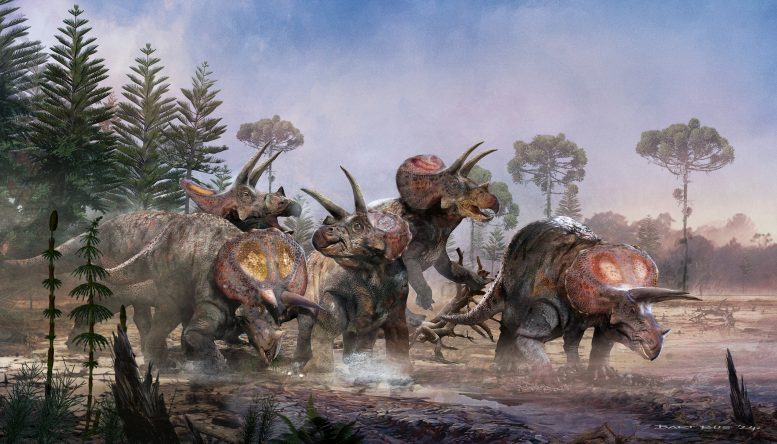
New Research Reveals That Real Triceratops Herds Echo Jurassic Park
-
by Anoop Singh
- 6

In a surprising turn of events, a team from the Naturalis Biodiversity Center unearthed over 1,200 Triceratops bones in Wyoming. The image above depicts a herd of Triceratops horridus walking through a Cretaceous swamp. Credit: Bart Bus
Research indicates that a group of five three-horned dinosaurs lived and died together.
From The Land Before Time to Jurassic Park, the famous horned dinosaur Triceratops is shown living in herds. There wasn’t really much of a reason for this if you looked at the fossil record of the species. Until now: years of research into a bonebed with five of these dinosaurs show that the animals lived and died as a group.
Actually, the team from Naturalis Biodiversity Center in the Netherlands was looking for a Tyrannosaurus, that summer of 2013 in Wyoming. Instead, they found a Triceratops: the famous dinosaur with the three horns and the large neck frill. And then they found another one. And another one. And more. The dig turned into a project that would last for more than ten years.
All in all, they dug up 1200 bones and bone fragments, of at least five individuals. A team of professional and volunteer paleontologists and technicians spent years removing them from the quarry. A researcher was hired to study the fossils: how did these dead dinosaurs end up there, together? What do their bones tell us of their lives and their deaths? That researcher has now reached a milestone: on Wednesday March 27 paleontologist Jimmy de Rooij hopes to receive the title of PhD from Utrecht University.
A herd of triceratops walking through a swamp. Credit: Naturalis Biodiversity Center
Insights from the Past
“The material is of very good quality,” De Rooij reflects on the dino detective story that is his PhD thesis. “This enabled us to show that these triceratops grew really slowly, for instance.” The details of the bonebed indicate that the five dinosaurs died together, possibly mired in a swamp. They are in a thin layer of rock, without bones of other species.
Research into the physical and chemical properties of the hundreds of triceratops teeth tells of a migratory existence – one that was the same for all five of the dinos. In other words: this species of dinosaur teamed up, at least occasionally. “And that of course leads to all kinds of new questions,” De Rooij says: “How complex was this social behavior, exactly?”
De Rooij’s supervisor, Prof. Anne Schulp (Naturalis/Utrecht University), is very happy about the entire trajectory from dig to defense ceremony. “Naturalis, the national natural history museum of the Netherlands, now has the biggest triceratops find in the world, and Utrecht University has the first Dr Triceratops in the Netherlands. De Rooij’s work didn’t just result in research papers, but also in an exhibition about his findings. As of October, the exhibition will kick off at Naturalis – and kick off the world tour – where the five triceratops are shown as they lived and died 67 million years ago: together.”
Reference: “Bringing fossils back to life: New insights on the biology of the iconic dinosaur Triceratops” by Jimmy de Rooij, 27 March 2024.
The study was funded by the Dutch Research Council (NWO).
In a surprising turn of events, a team from the Naturalis Biodiversity Center unearthed over 1,200 Triceratops bones in Wyoming. The image above depicts a herd of Triceratops horridus walking through a Cretaceous swamp. Credit: Bart Bus Research indicates that a group of five three-horned dinosaurs lived and died together. From The Land Before Time…
In a surprising turn of events, a team from the Naturalis Biodiversity Center unearthed over 1,200 Triceratops bones in Wyoming. The image above depicts a herd of Triceratops horridus walking through a Cretaceous swamp. Credit: Bart Bus Research indicates that a group of five three-horned dinosaurs lived and died together. From The Land Before Time…
